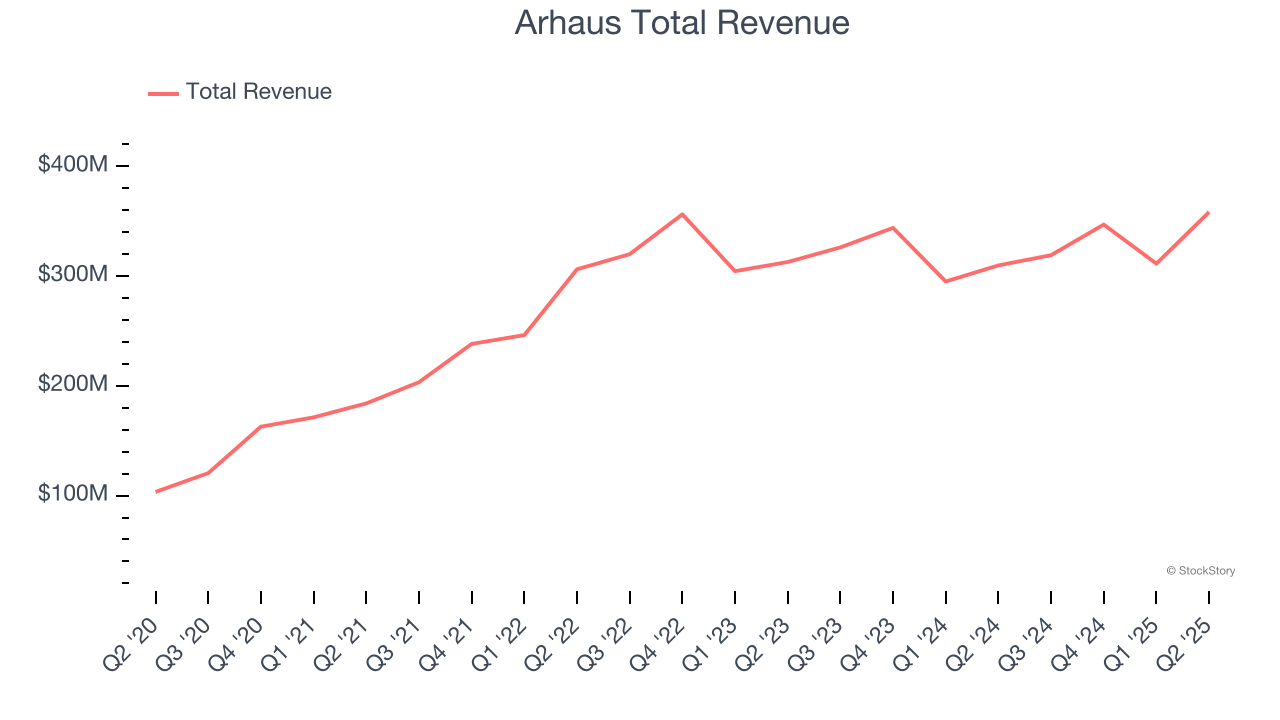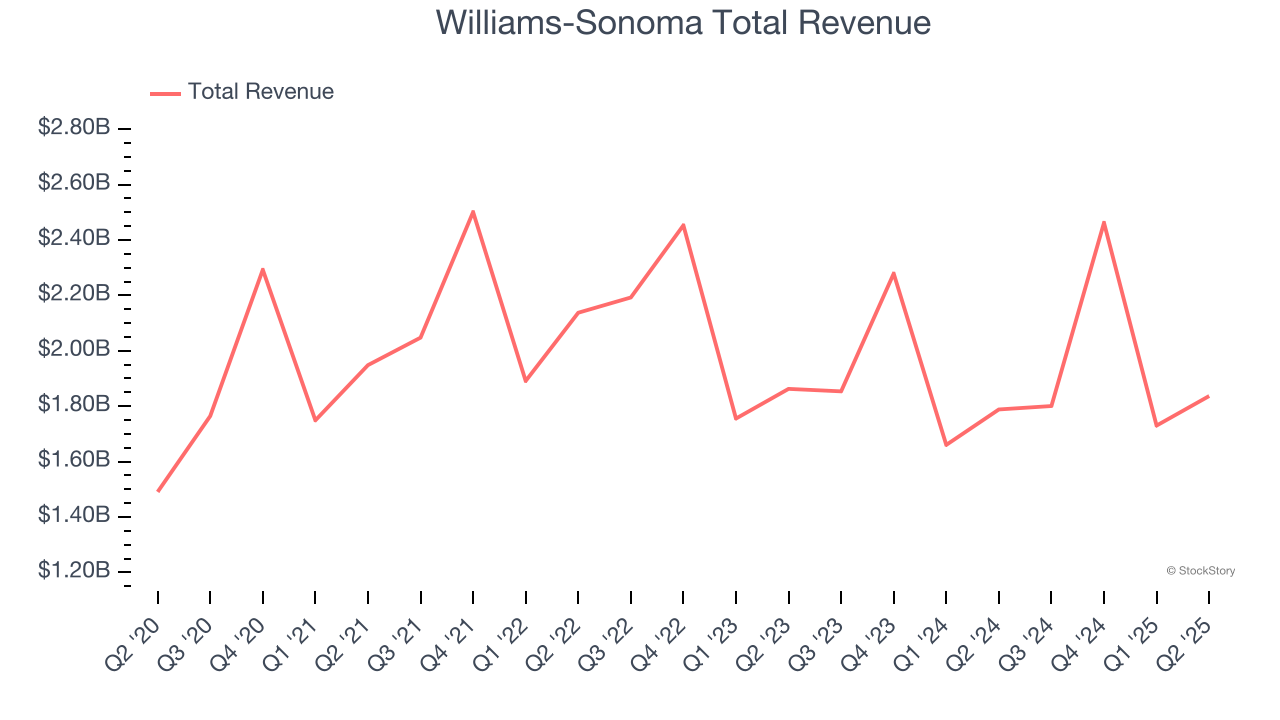
As the Q2 earnings season wraps, let’s dig into this quarter’s best and worst performers in the home furniture retailer industry, including Arhaus (NASDAQ:ARHS) and its peers.
Furniture retailers understand that ‘home is where the heart is’ but that no home is complete without that comfy sofa to kick back on or a dreamy bed to rest in. These stores focus on providing not only what is practically needed in a house but also aesthetics, style, and charm in the form of tables, lamps, and mirrors. Decades ago, it was thought that furniture would resist e-commerce because of the logistical challenges of shipping large furniture, but now you can buy a mattress online and get it in a box a few days later; so just like other retailers, furniture stores need to adapt to new realities and consumer behaviors.
The 4 home furniture retailer stocks we track reported a mixed Q2. As a group, revenues along with next quarter’s revenue guidance were in line with analysts’ consensus estimates.
Amidst this news, share prices of the companies have had a rough stretch. On average, they are down 8.4% since the latest earnings results.
Best Q2: Arhaus (NASDAQ:ARHS)
With an aesthetic that features natural materials such as reclaimed wood, Arhaus (NASDAQ:ARHS) is a high-end furniture retailer that sells everything from sofas to rugs to bookcases.
Arhaus reported revenues of $358.4 million, up 15.7% year on year. This print exceeded analysts’ expectations by 7.4%. Overall, it was an exceptional quarter for the company with EBITDA guidance for next quarter exceeding analysts’ expectations and a beat of analysts’ EPS estimates.

Arhaus scored the biggest analyst estimates beat and fastest revenue growth, but had the weakest full-year guidance update of the whole group. Unsurprisingly, the stock is up 7.3% since reporting and currently trades at $10.60.
Is now the time to buy Arhaus? Access our full analysis of the earnings results here, it’s free for active Edge members.
Williams-Sonoma (NYSE:WSM)
Started in 1956 as a store specializing in French cookware, Williams-Sonoma (NYSE:WSM) is a specialty retailer of higher-end kitchenware, home goods, and furniture.
Williams-Sonoma reported revenues of $1.84 billion, up 2.7% year on year, in line with analysts’ expectations. The business had a very strong quarter with a solid beat of analysts’ gross margin and EBITDA estimates.

Although it had a fine quarter compared its peers, the market seems unhappy with the results as the stock is down 3.4% since reporting. It currently trades at $190.91.
Is now the time to buy Williams-Sonoma? Access our full analysis of the earnings results here, it’s free for active Edge members.
Weakest Q2: Sleep Number (NASDAQ:SNBR)
Known for mattresses that can be adjusted with regards to firmness, Sleep Number (NASDAQ:SNBR) manufactures and sells its own brand of bedding products such as mattresses, bed frames, and pillows.
Sleep Number reported revenues of $327.9 million, down 19.7% year on year, falling short of analysts’ expectations by 8.3%. It was a disappointing quarter as it posted a significant miss of analysts’ revenue and EPS estimates.
Sleep Number delivered the highest full-year guidance raise but had the weakest performance against analyst estimates and slowest revenue growth in the group. As expected, the stock is down 18.5% since the results and currently trades at $6.65.
Read our full analysis of Sleep Number’s results here.
RH (NYSE:RH)
Formerly known as Restoration Hardware, RH (NYSE:RH) is a specialty retailer that exclusively sells its own brand of high-end furniture and home decor.
RH reported revenues of $899.2 million, up 8.4% year on year. This result was in line with analysts’ expectations. Zooming out, it was a slower quarter as it logged a miss of analysts’ EBITDA estimates and revenue guidance for next quarter missing analysts’ expectations.
The stock is down 19.1% since reporting and currently trades at $185.03.
Read our full, actionable report on RH here, it’s free for active Edge members.
Market Update
Thanks to the Fed’s series of rate hikes in 2022 and 2023, inflation has cooled significantly from its post-pandemic highs, drawing closer to the 2% goal. This disinflation has occurred without severely impacting economic growth, suggesting the success of a soft landing. The stock market thrived in 2024, spurred by recent rate cuts (0.5% in September and 0.25% in November), and a notable surge followed Donald Trump’s presidential election win in November, propelling indices to historic highs. Nonetheless, the outlook for 2025 remains clouded by potential trade policy changes and corporate tax discussions, which could impact business confidence and growth. The path forward holds both optimism and caution as new policies take shape.
Want to invest in winners with rock-solid fundamentals? Check out our Hidden Gem Stocks and add them to your watchlist. These companies are poised for growth regardless of the political or macroeconomic climate.
StockStory is growing and hiring equity analyst and marketing roles. Are you a 0 to 1 builder passionate about the markets and AI? See the open roles here.
